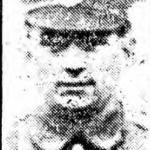BORN HULL 1894. YOUNGEST SON OF JOHN & ELIZABETH MATSON 9 EBENEZER TERRACE, WEST DOCK AVENUE, HULL (ARMY RECORDS ADDRESS) A FISH HOUSE LABOURER (1911 CENSUS) AND WORKING FOR THE NORTH EASTERN RAILWAYS AT HULL DOCKS, WHEN WAR BEGAN. DESCRIBED AS 5 FOOT, 4 INCHES TALL, 37 INCH CHEST SIZE, 137 LBS WEIGHT AND “GOOD” PHYSICAL DEVELOPMENT.
HE ENLISTED IN BEVERLEY AND CALLED UP FOR SERVICE, ON 21/01/1916. SERVED WITH THE 8TH EAST YORKSHIRE REGIMENT. POSTED TO FRANCE, ON 13/05/1916. DIED OF WOUNDS, ON 16/07/1916, AGED 23. HE IS COMMEMORATED ON THE THIEPVAL MEMORIAL, TO THE MISSING, ON THE SOMME. HIS ARMY EFFECTS WERE LEFT TO HIS WIDOWED MOTHER, ELIZABETH. HE WAS UNMARRIED. HIS DEATH WAS REPORTED IN THE HULL DAILY MAIL, ON 25/08/1916. *
HE LEFT ONLY BROTHER, THOMAS WILLIAM MATSO, AND THREE MARRIED SISTERS, HELDA, EMMIE AND MINNIE, WHO LIVED AROUND HESLLE ROAD, HULL.
Somme – The 8th East Yorkshires spent the following weeks alternating between resting, training, and spells in the line near Dickebusch, while preparations went on further south for that summer’s ‘Big Push’ (the Battle of the Somme). The battalion entrained for the Somme on the day the offensive began, 1 July. It went into brigade reserve when 3rd Division took over the Caterpillar Wood sector near Montauban, providing carrying parties and night patrols. After the disasters of the first day, 3rd Division in conjunction with three others was to make a daring night assembly and dawn attack on 13/14 July (the Battle of Bazentin Ridge). The Brigade Intelligence Officer had placed a screen of picquets and scouts out in No man’s land within 200 yards (180 m) of the enemy line and the assaulting troops slowly moved up in the hours of darkness to a sunken lane just short of this line. They then moved forwards 15 yards every 15 minutes until they were on their jumping-off tapes about 120 yards (110 m) from the enemy by 03.15; 8th EYR was on the right of 8th Bde’s line, with half of 1st Royal Fusiliers in support. At 03.20 a sudden intense bombardment was placed on the German barbed wire and trenches and five minutes later the whole attacking line of four divisions advanced behind a Creeping barrage. Along most of the line the German resistance was feeble; unfortunately the wire in front of 8th Bde was hardly touched, there were just a few breaks in the first belt and none in the second. Two platoons of the 8th EYR managed to get through on the right, the remainder had to shelter in shell holes in front of the wire or retire to the sunken road. Lieutenant-Colonel Way was wounded in the wire and Maj Brewis came up to take temporary command once more. Later a bombing party from 2nd Royal Scots came down from the left and cleared the Germans out of the trench in front of the battalion, but of the two platoons that had penetrated, no more was heard. In what was largely a successful British attack, the battalion had suffered severely, with 8 officers killed and 11 wounded, 81 other ranks killed, 218 wounded, and 141 missing, over half the initial strength of the battalion. Even when the battalion took over the opposing trenches they were heavily shelled with high explosive (HE) and gas until they were relieved on 20/21 July 1916.
